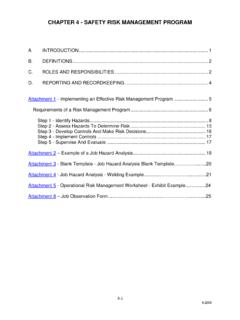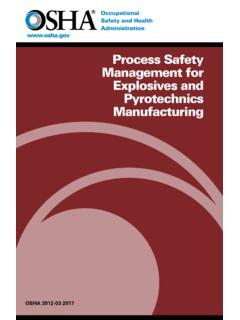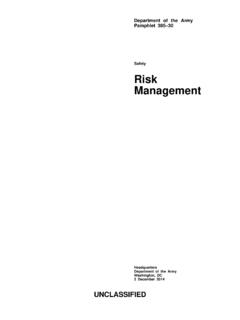Transcription of Process Safety Management for Storage Facilities
1 OSHA 3909-03 2017 Process Safety Management for Storage FacilitiesOccupational Safety and Health Act of 1970 To assure safe and healthful working conditions for working men and women; by authorizing enforcement of the standards developed under the Act; by assisting and encouraging the States in their efforts to assure safe and healthful working conditions; by providing for research, information, education, and training in the field of occupational Safety and health. This guidance document is not a standard or regulation, and it creates no new legal obligations. It contains recommendations as well as descriptions of mandatory Safety and health standards. The recommendations are advisory in nature, informational in content, and are intended to assist employers in providing a safe and healthful workplace. The Occupational Safety and Health Act requires employers to comply with Safety and health standards and regulations promulgated by OSHA or by a state with an OSHA approved state plan.
2 In addition, the Act s General Duty Clause, Section 5(a)(1), requires employers to provide their employees with a workplace free from recognized hazards likely to cause death or serious physical contained in this publication is in the public domain and may be reproduced, fully or partially, without permission. Source credit is requested but not information will be made available to sensory impaired individuals upon request. Voice phone: (202) 693 1999; teletypewriter (TTY) number: 1 877 889 5627. Process Safety Management for Storage Department of LaborOccupational Safety and Health AdministrationOSHA 3909 03 2017 ContentsPurpose ..1 Applicability ..4 Employee Participation ..6 Process Safety Information ..6 Information on Highly Hazardous Chemicals ..7 Information on Process Technology ..7 Information on the Process Equipment ..8 Process Hazard Analysis (PHA) ..9 Operating Procedures ..11 Training ..12 Mechanical Integrity ..13 Emergency Planning and Response.
3 15 APPENDIX: Misconceptions and Frequently Asked Questions ..17 Workers Rights ..21 OSHA Assistance, Services and Programs ..21 Establishing a Safety and Health Program ..21 Compliance Assistance Specialists ..21 Free On site Safety and Health Consultation Services for Small Business.. 21 Cooperative Programs ..22 Occupational Safety and Health Training Courses ..23 OSHA Educational Materials ..23 OSHA Regional Offices ..24 How to Contact OSHA ..27 Process Safety Management FOR Storage FACILITIES1 PurposeThis document does not cover the entire Process Safety Management (PSM) standard, but only focuses on aspects of the standard particularly relevant to Storage Facilities . For a full compliance guide to PSM, please refer to OSHA 31321 or the full text of the standard at Although all elements of the PSM standard apply to a PSM covered Storage facility, the following elements of the standard are most relevant to hazards associated with Storage Facilities : Employee Participation Process Safety Information (PSI) Process Hazard Analysis Operating Procedures Training Mechanical Integrity (MI) Emergency Planning and ResponsePSM is critically important to Facilities that store highly hazardous chemicals.
4 implementing the required Safety programs help prevent fires, explosions, large chemical spills, toxic gas releases, runaway chemical reactions, and other major incidents. This will ensure that employees, contractors, facility visitors and emergency responders are safe from these hazards. Compliance will also benefit employers by minimizing damage to facility equipment and neighboring structures in the event of an HHC release. Between 1997 and 2013, there have been numerous incidents at Storage Facilities that have caused serious injuries and fatalities to employees. Several examples are included below: In 2013, a facility that stored and distributed compressed propane gas was largely destroyed by a series of fires and explosions. After receiving spent propane gas cylinders, employees would bleed any remaining gas into the air 1. Safety AND HEALTH ADMINISTRATION2before the cylinders were cleaned and reused. On the night of the incident, investigators believe, this practice resulted in a cloud of flammable propane gas at the facility, which was ignited by a spark from a forklift operating in the area.
5 The resulting explosions and fires injured several employees four critically. In 2008, a nearly 90 year old Storage tank catastrophically failed and released approximately million gallons of liquid fertilizer. The collapsing tank seriously injured two employees, and the chemicals flowed over containment berms. Investigators determined that defective welds likely caused the tank failure, and inspectors condemned another tank at the same facility that presented an imminent danger of failure. Major contributing factors were the inadequacy of tank weld inspections and overestimates of the maximum liquid levels that the tank could safely accommodate. Further, some tank inspection and testing activities did not follow recognized and generally accepted good engineering practices. This is a recurring category of incident: between 1995 and 2008, 16 tanks at other Facilities catastrophically failed, killing one employee and hospitalizing four others. Faulty welding caused 11 of these tank failures (CSB, 2009).
6 In 2005, a fire and subsequent explosion(s) destroyed a facility that stored and distributed compressed gas, and propelled debris and projectiles. The incident was traced back to propylene gas cylinders in the facility s Storage area that were directly exposed to sunlight. High temperatures from the sunlight exposure increased cylinder pressure enough to cause flammable vapors to leak from the cylinders and catch fire. Heat from the initial fire caused other cylinders to leak gas. The fire spread throughout the Storage area and eventually consumed nearly 8,000 cylinders of compressed gas. In 2003, an industrial facility that stores and distributes chlorine received a routine railcar shipment of liquid chlorine. The chlorine was transferred to a bulk trailer, a procedure that the facility had conducted for many Process Safety Management FOR Storage FACILITIES3years without serious incident. The loading Process was equipped with a scrubber, which was designed to control chlorine vapors displaced during trailer filling.
7 On the day of the incident, chlorine vapors overwhelmed the scrubbers capacity, and up to 1,920 pounds of chlorine escaped into the air. This incident occurred in a Process for which a Process hazard analysis had already been conducted. However, investigators found that the Process hazard analysis failed to consider the consequences of chlorine gases overloading the scrubbers (CSB, 2007). In 1999, a truck driver was killed and an employee injured when a chemical shipment was inadvertently loaded into the wrong tank. Due to this error, incompatible chemicals came into contact, reacted, and released a cloud of toxic gas containing lethal levels of hydrogen sulfide. In this case, the employer s failure to have adequate Process Safety information on chemical incompatibilities, its inadequate chemical unloading procedures, and its failure to implement appropriate controls all contributed to the incident (NTSB, 2001). Other similar incidents have been recorded. A 1998 incident investigated by the National Transportation Safety Board (NTSB) occurred when inadvertent mixing of incompatible chemicals at a facility s loading dock released toxic gases.
8 That incident injured seven people including two first responders and caused 3,000 workers to be evacuated or instructed to shelter in place (NTSB, 2000). In 1997, three firefighters were killed by flying debris from an explosion in the Storage area of a pesticide distribution facility. Investigators concluded that the explosion was most likely caused by a sack of thermally unstable material that had been placed too close to a hot compressor discharge pipe. The heat from the pipe caused the material to decompose and release flammable vapors, which eventually ignited and exploded. The investigators recommended that Safety programs to review hazards should be implemented at all Facilities that store, manufacture, handle, or use hazardous chemicals (EPA 1999).OCCUPATIONAL Safety AND HEALTH ADMINISTRATION4 Applicability The Process Safety Management standard covers processes which involve a chemical at or above the specified threshold quantity (TQ) listed in Appendix A of the PSM standard3, unless another Federal Agency has The PSM standard is also applicable to processes containing a Category 1 flammable gas (as defined in (c)) or a flammable liquid with a flashpoint below 100 F ( C) on site in one location, in a quantity of 10,000 pounds ( kg) or more.
9 A Process is defined by OSHA in the PSM standard as any activity involving a highly hazardous chemical including any use, Storage , manufacturing, handling, or the on site movement of such chemicals, or combination of these activities. 5 The standard also states that any group of vessels which are interconnected and separate vessels that are located such that a highly hazardous chemical could be involved in a potential release, shall be considered a single following operations are excepted from the PSM standard s scope, which may apply to some Storage Facilities : Retail Facilities Hydrocarbon fuels used solely for workplace consumption as a fuel ( , propane used for comfort heating, gasoline for vehicle refueling), if such fuels are not a part of a Process containing another highly hazardous chemical (HHC) covered by the PSM standard Flammable liquids with a flashpoint below 100 F ( C) stored in atmospheric tanks or transferred which are kept below their normal boiling point without benefit of chilling or refrigeration.
10 (Note: Atmospheric tanks are Storage tanks designed to operate at pressures from atmospheric through psig)3. Calculation of TQ for mixtures is explained in an OSHA Letter of Interpretation at Section 4(b)(1) of the OSH Act, 29 653(b)(1), provides that OSHA has no authority to regulate a working condition if another federal agency exercises statutory authority to prescribe or enforce a standard or regulation addressing that working condition. Thus, except as noted, if another federal agency has or enforces a standard or regulation addressing accidental releases of regulated substances, the OSH Act does not apply to that working condition. 5. 29 CFR Safety Management FOR Storage FACILITIES5 Oil or gas well drilling or servicing operations6 Normally unoccupied remote facilities7 All Storage Facilities that do not fit under one of these exemptions should determine whether they fall under the OSHA PSM standard and comply with the standard if they do. Storage Facilities typically have considerably less complex Process Safety issues than Facilities with large chemical manufacturing operations, which may make compliance easier and less costly.















